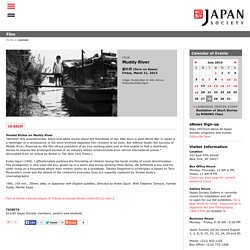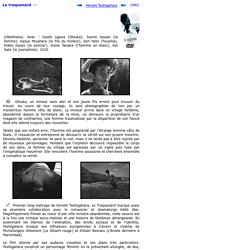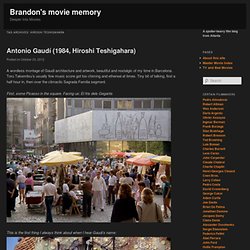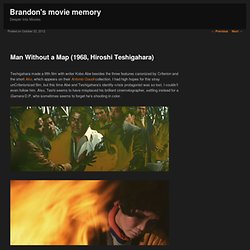

Teshigahara, Abe and Takemitsu: A Unique Collaboration in 1960s Japanese Cinema. Introduction If I was ever forced to choose, I would have to pick 1960s Japanese cinema as the greatest pound-for-pound decade of any national cinema. If it seems a surprising choice, just bear in mind the abundance of riches all co-inciding in this same decade.
The old masters who’d started in the silent era (Ozu, Naruse) were still making masterpieces. The generation of directors who broke through post-war (Kurosawa, Ichikawa, Kobayashi, Shindo) are still in their prime and making some of their best films. And then, there’s the incredible innovation and energy of the Japanese New Wave crashing into the picture (Oshima, Imamura, Shinoda, etc), not to mention the jazzy psychedelic yakuza pulp films of Suzuki Seijun or lots of other great genre film-making. And in the midst of all these came some genuine “UFOs”, unclassifiable films that don’t quite fit in any category but only serve to make 1960s Japan an even more fascinating cinematic terrain to explore.
Jose Torres (1959). Like this: Muddy River. eNews Sign-up Stay informed about all Japan Society programs and events.Subscribe Now Visitor Information Location 333 East 47th Street New York, NY 10017 Box Office Hours: Monday–Thursday, 11 AM–6 PM, Friday, 11 AM–9 PMCheck our Visit page for current weekend hours.

Gallery Hours: Japan Society Gallery is currently closed for installation and will re-open for our fall exhibition, For a New World to Come: Experiments in Japanese Art and Photography, 1968-1979, on October 9. Le traquenard de Hiroshi Teshigahara. Otsuka, un mineur sans abri et son jeune fils errent pour trouver du travail.

Au cours de leur voyage, ils sont photographiés de loin par un mystérieux homme vêtu de blanc. Le mineur arrive dans un village fantôme, abandonné depuis la fermeture de la mine, où demeure la propriétaire d’un magasin de confiseries, une femme traumatisée par la disparition de son fiancé dont elle attend toujours des nouvelles. Tandis que son enfant erre, l'homme est poignardé par l'étrange homme vêtu de blanc. Il ressuscite et entreprend de découvrir la vérité sur son propre meurtre. Devenu fantôme, personne ne peut le voir, mais il ne tarde pas à être rejoint par de nouveaux personnages. Premier long-métrage de Hiroshi Teshigahara, Le Traquenard marque aussi sa première collaboration avec le romancier et dramaturge Kôbô Abe.
Le film étonne par ses audaces visuelles et ses plans très particuliers. Chez Teshigahara, la douleur se lit d'abord sur les corps. "On a commencé par les mines. Traquenard (Otoshiana) (1962) d'Hiroshi Teshigahara. Premier long-métrage deTeshigahara et première collaboration avec Abe Kobo (On leur devra par la suite le troublant La Femme des sables, même si le bouquin reste définitivement un ton au-dessus du long-métrage), cette oeuvre entre film noir et film fantastique est vraiment une perle japonaise.

Paysage désertique de mines, atmosphère ultra étouffante - tous les personnages transpirent autant que Carlos quand il pêche un mérou -, manipulation infernale sur fond de guerre de syndicats, individus qui, une fois morts, reprennent leur enveloppe corporelle mais deviennent invisibles aux yeux des vivants, les deux artistes semblent s'entendre à la perfection pour parvenir à traduire en images ce r écit d'une imagination bouillonnante. Sublime scène que celle d'un homme en blanc sortant de nulle part poursuivant un mineur avant de l'assassiner sauvagement dans la boue à coups de couteau. Brandon's movie memory. Patriotism (1966, Yukio Mishima) Wow.

Silent film in the Noh style, no dialogue or effects, just long, scrolling intertitles and a scratchy Wagner record on the soundtrack. Very simple story – Mishima adapting and minimizing his own story, directing, starring, hand-writing the title cards, etc. Lt. Takeyama’s buddies attempted to overthrow the government. T. Mishima’s idiosyncratic reading of “patriotism” is underscored by the kakemono scroll that hangs on the back wall of the stage. Spacy (1981, Takashi Ito) Ten minutes of re-cut recursion. Man Without a Map (1968, Hiroshi Teshigahara) Teshigahara made a fifth film with writer Kobo Abe besides the three features canonized by Criterion and the short Ako, which appears on their Antonio Gaudi collection.

I had high hopes for this stray unCriterionized film, but this time Abe and Teshigahara’s identity-crisis protagonist was so lost, I couldn’t even follow him. Also, Teshi seems to have misplaced his brilliant cinematographer, settling instead for a Gamera D.P. who sometimes seems to forget he’s shooting in color. There’s plenty of visual interest, though – there are some wild geometric patterns and treated images, sudden shocks of yellow and red, and nice cinemascope compositions. The camera sometimes spies on people not in conversation, as if doing its own detective work. Our hero has a dialogue with a man we only see grotesquely reflected in a glass. Related posts.